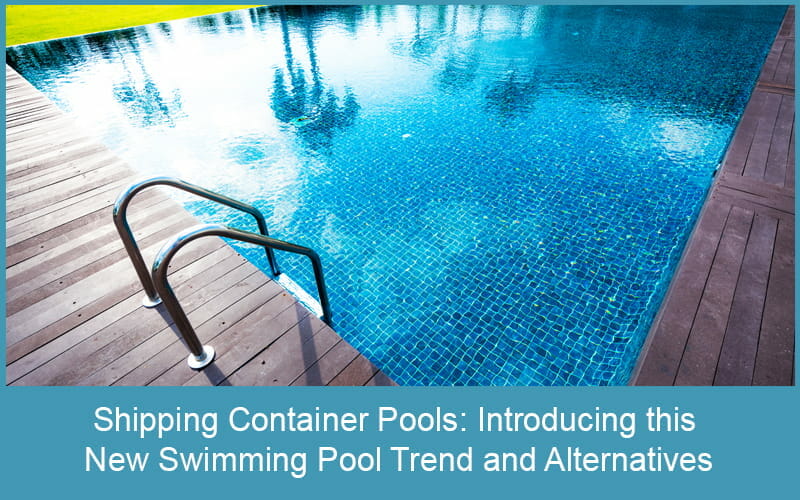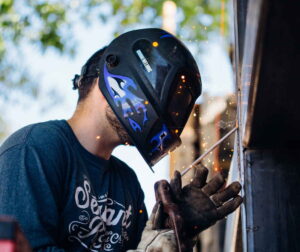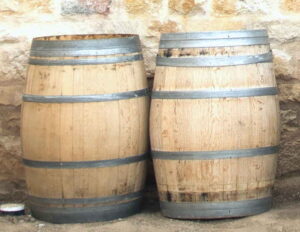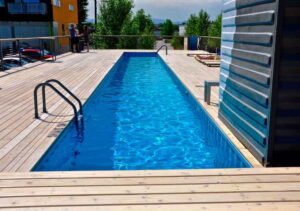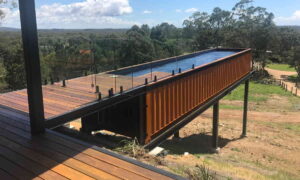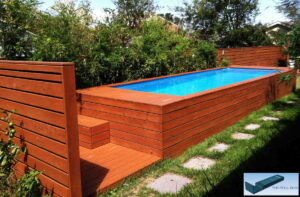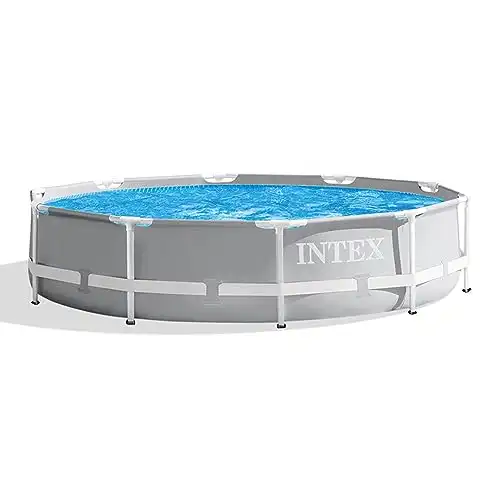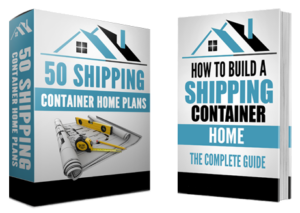You’ve likely seen shipping container pools while scrolling through your social media feeds or on news stories about the latest trends in real estate. However, details about how they are built, where to get one, and how much they cost have always been hard to come by. We’re here to fix that.
It isn’t a huge mental leap to think of adding water to a strong, durable, weathertight box. But there is actually quite a bit of thought and planning that goes into one of these modern swimming pools.
Whether you want to build your own shipping container pool or buy one pre-made from a company, this article will absolutely help. We’re going to go over all the important things you need to know about this new swimming pool trend and share some beautiful examples. And if you decide you still want a swimming pool, but with a different construction method, we’ll cover some affordable alternatives as well.
Shipping Container Swiming Pool Benefits
The best place to start is covering why someone would even want a shipping crate pool to begin with. Below are the most common reasons to consider one.
Affordable
Much like the overall affordability of container homes, comparing the prices of traditional pools and shipping container pools is a bit tricky. It’s a little unfair to look at two things that provide the same general function (swimming) in such different ways.
Most container pools are fully or mostly above-ground. And yet, they’re typically compared to in-ground traditional pools because of similar quality, strength, and durability.
With that said, in many cases, conex box pools are considered to be more affordable than a similarly equipped in-ground pool. We’ll cover the prices in more detail in a later section.
The cost savings you do uncover may end up being more apparent with added features that advantage containers. For instance, adding an infinity pool requires both the perimeter and especially the waterfall edge of the container to be perfectly level, something much easier to achieve with a container.
Keep in mind that there are cheap above-ground pools that we’ll discuss in the alternatives section later, but these aren’t very resilient and you’re usually lucky if they last more than a few years.
Durable
Container homes are famous for their strength and durability, and container pools have the same traits. The steel boxes that form a container pool are comfortable supporting enormous loads and dealing with the stresses of open-sea travel.
It means the pool can withstand the stresses of a busy family and should last for years to come. Of course, like any pool, they will require periodic maintenance. But from a durability standpoint, you should be in a good position.
Flexible Configuration
We shared earlier that most container pools are built above ground, but that isn’t an absolute rule. With the right planning and preparation, you could build a conex pool underground as well (though at that point, a traditional pool might be a better choice).
One configuration possibility is placing a container pool on uneven ground. A container pool with necessary structural modifications is so strong that it doesn’t need continual support underneath.
Instead, it can be supported on the edges or even the ends. This allows you to place container pools on building sites that would be almost impossible with traditional pools.
Another flexibility feature is using the oblong dimensions of a container to your advantage. Their long, narrow shape makes them ideal for applications like endless pools, where cardiovascular exercise, rather than recreation, is the primary goal.
Quick Setup
Due to the fact that container pools can be built off-site, the amount of on-site work required is minimal. Other than the provisions you may need for a foundation (discussed elsewhere in this article), the balance of the preparations can be done in a single day.
This means that you could order a container pool and theoretically be swimming the same day it arrives. In most cases, you just have to set it in place, hook it up to the utilities, and fill it up with water.
No noisy machines, construction workers, and a torn-up yard for weeks. How’s that for convenience and low impact!
Eco-Friendly
If you choose to build your container pool from a used shipping container, you also have the benefit of increased eco-friendliness. It’s the same reason many people gravitate toward container homes as well.
Reusing or upcycling a shipping container that is beyond its useful life for shipping cargo, but still suitable for other purposes, is a great way to think and act green. If you’re using a builder, you’ll have to ask if they offer this option. With a DIY build, you’re in complete control of container sourcing.
Increased Home Value
Like all other types of pools, a container pool is an amenity for your home. Yes, you’ll benefit from it while you live there, but when it’s time to sell, it may also increase the value of your home too.
A lot of this depends on your geographic area (warmer areas where pools can be used year-round are better) and your neighborhood (higher-end areas where buyers expect a pool will see it valued more highly). While a pool isn’t always a net benefit, if you’re smart about it, a pool can add value.
But wait, there’s another option if you choose to move…
Portable
In the same way that a container pool arrives at your property, it can also depart: via a truck. Yes, a container pool is only a semi-permanent addition to your home.
If you want to leave your container pool in place forever, you can certainly do that. But if you want to bring it with you to your next house, that’s a fairly reasonable option to pursue.
You’ll obviously have to drain it, unhook the utilities, and remove any decking or trim that surrounds the pool but isn’t actually attached. Then, with the help of a crane or other equipment, you can load the pool onto a truck and send it to your next dream home. This is perhaps one of the most unique benefits!
Shipping Container Pool Drawbacks
Despite all the benefits, it’s only fair to recognize that container swimming pools do have some downsides. Depending on your requirements, some of these may be more relevant than others.
Size and Layout
Almost all container pools are built from the most common container sizes, 20 ft and 40 ft long general-purpose units. Some companies have grafted multiple containers together to make longer or wider pools, but this is rare.
So in the vast majority of cases, your pool is going to be an 8 ft wide rectangle, 20 to 40 ft long. Organic shapes and curves simply aren’t possible.
Additionally, a container pool could at most only be 9 ft deep (with a high-cube container as the starting point) without extensive modification. So if you’re looking for a diving well or a place for pool volleyball, a container pool probably isn’t the best choice. But for a plunge pool or even a lap pool, a container pool would be great.
Temperature Control
At Discover Containers, we’ve talked extensively about heat transfer in shipping containers, and those principles are relevant for pools as well. It’s a concept that is especially important for those of you in colder climates who intend to use a pool heater that will extend your pool season.
Due to the metal construction of a container pool, it will do a great job radiating heat outward away from the pool. Unfortunately, you would want that heat to stay inside.
In order to prevent this, you’d need to insulate the outside of the container. In a way, this mimics the slight insulation provided to traditional in-ground pools by the surrounding earth. Without insulation, you’ll have huge heating bills for your container pool.
Unconventional Appearance
When most people think about a backyard swimming pool, they have an image in their mind… and that image isn’t a pool made from a shipping container. Whether your container pool will actually be better or worse than the one they imagined is debatable. But it will almost certainly be different.
For some people, especially those with more traditional architectural styles in their homes, the addition of a container pool may simply feel too striking. While you can try to match an existing building by using exterior cladding, it’s hard to hide the sharp, geometric lines of a shipping container.
However, if you have a modern home, or just want to really make a ‘splash’ with your pool, the bold design of a metal box may be exactly what you’re looking for. Remember though, it’s not always just you that you have to think about. Future buyers, homeowners associations (HOAs), and other entities may have an opinion as well.
Frequently Asked Questions about Container Swimming Pools
If you’re on board with the general concept of cargo container pools but still have some questions and concerns, you’re in the right place. Listed below are some of the most common questions people have about these types of pools, along with the corresponding answers.
How do you Handle the Delivery of a Container Pool?
Unless you’re doing an in-place do-it-yourself build, your shipping container swimming pool is going to be fabricated offsite. And that means when it’s ready, it will have to be brought to your home.
While there are a few different methods to safely offload your container pool, the most likely choice will be a small crane. This gives you a few things to think about.
First is where the truck carrying the container can drive and park to get as close to the pool site as possible. And next is where the crane (assuming it’s detached) can drive, place its outriggers, swing its boom, etc. With trees, fences, nearby buildings, underground pipes, and overheads wires, it takes a carefully orchestrated dance to get everything placed without incident!
Will a Container Pool Rust?
Shipping containers are made from weathering steel with a special alloy mixture that causes them to quickly form a thin layer of oxidation that shouldn’t go deeper into the material or flake off. However, this isn’t a 100% solution and container rust can be a real problem without proper care and maintenance.
The weathering steel only slows the rate of corrosion, it doesn’t completely stop it. Placing a shipping container where it is constantly wet is a tough environment in general. And then add on the fact that chemicals used to keep the pool water clean only accelerate corrosion, and you have a serious issue.
Luckily, high-quality coatings exist that will completely cover the metal and keep rust from appearing. No, they won’t last forever and at some point, years down the road, you’ll likely have to apply the coating. But as long as you’re attentive to the condition of your pool, you can certainly manage the risk of corrosion.
Do I need Permits or other Approvals to Install a Shipping Container Pool?
If you live in a city or town and undertake an exterior construction project, typically your local officials are going to want to know. A container pool arguably straddles the line between a temporary piece of equipment and a permanent structure, so what is required is more nuanced.
However, it’s fairly safe to assume that you’ll likely need some type of approval (If not for the pool itself, then perhaps for the foundation construction and utility hookups). Exactly what requirements you’ll need to comply with and who will be involved will vary based on your location. Our article on container home building codes and zoning is a good place to start understanding the regulatory ecosystem.
Generally, you’ll find there are rules and regulations governing swimming pool installations all over the world. You certainly want to avoid situations like flooding your neighbor’s yard, electrocuting your pool guests, or letting a child gain access to the pool unintended. These are the kinds of things pool regulations are often trying to protect against.
For those who happen to live in more rural areas outside the control of a city government, you may face little or no regulatory hurdles. But you still need to be extremely careful in your design and construction, given the tremendous risks a pool can present.
What Sizes of Container Pools are Available?
As we described in an above section, the majority of container pools are made from 20 ft and 40 ft general purpose shipping containers, both of which are 8 feet wide. Oftentimes, the top few feet of the container are cut off, making the pool 3 to 5 feet deep (and less heavy).
While it’s possible to graft two containers together and make a pool that is longer or wider than a standard container, this is uncommon and fairly expensive.
Do I need to Build a Foundation to Support my Container Pool?
It should come as no surprise that a shipping container full of water is very heavy. In order to prevent your pool from sinking or becoming unevenly set in your yard, some type of foundation is usually required.
We’ll talk in more detail about foundations later in the article, but in general, you should expect to, at a minimum, need a thick pad of compacted gravel under your container pool. Many people go with a concrete perimeter foundation or use several piers to provide support
Where can you Place a Container Pool?
We talked about the flexibility of container pools being one of their main benefits and this really shows itself in the variety of placement options. In one sense, the overall size of container pools allows them to be placed in compact yards and areas where larger, traditional pools would never fit.
In another way, the strength of a fabricated container pool and the fact that is doesn’t necessarily need a flat-bottom foundation provides additional flexibility. In short, if you can construct some type of stem wall, pier, or other foundation strong enough to support a container pool, you can place it almost anywhere.
This has tremendous benefits for building sites with sloping, uneven terrain or other natural obstacles that a container pool can effectively bridge over. You can see a great example of this idea in action below in the Examples section with the Australian Hillside Pool.
You can also set a container pool adjacent to retaining walls, creating a hybrid aboveground and inground pool. There are really some unique placement possibilities.
What are some Interesting, Optional Container Pool Features?
By far, the most well-known feature is placing a window on the side of the container pool so you can see underwater from outside (and vice versa). It effectively turns your pool into a human aquarium and is something that is very rarely seen in most residential pools.
Some of the container pool manufacturers sell a removable dividing wall that can turn one end of your pool into a hot tub/jacuzzi, whenever you want. And just as easily, you can remove it and go back to a full-length pool.
There are also options you may be familiar with from traditional pools, like salt-water systems, water heaters, and unique lighting arrangements. And of course, there are phone apps available to control all of it with a swipe of your finger.
Is it possible to Finance a Shipping Container Pool?
Many established container pool manufacturers have agreements in place with third-party lenders who can offer loans to finance your pool. Even DIYers may be able to secure financing via a home equity loan, a personal/unsecured loan, or similar options.
How to Build a Container Pool and Install it
Building a container pool involves a bit more work than just plopping it down, cutting off the top, and filling it full of water. Below we’ll go over the major phases of work that need to take place, regardless of whether you’re buying or building yourself.
Unfortunately, there aren’t any companies offering a shipping container pool kit to our knowledge. Rather, you have to source all the components individually and combine them yourself.
Find a Suitable Location
You need to find a location that is not only workable from an installation perspective (discussed previously) but also works with your lifestyle and taste. Things to consider include privacy, sun exposure, appearance, and noise.
Get Local Permission
We already mentioned this one as well. Odds are good that you’ll need some type of approval for at least part of your container pool installation. You’ll have to ask your local authorities for specific requirements.
Hookup the Required Utilities
At a minimum, you’ll need access to water to fill up your pool when it first arrives. And thanks to evaporation and all the expected cannonball jumps, you’ll have to replenish the water every now and then as well.
You’ll also need to supply electricity for your container pool, including the pump, controller, lights, etc. While you could theoretically run everything off of a solar system with battery storage, just the pump will likely draw a few thousand Watts or more of electrical power.
If you’re planning to have a pool heater, you could use electricity for that as well. But most people choose to use propane or natural gas, which is typically more efficient.
Build the Foundation
A 40 ft container pool that’s about 4 ft deep has a volume of ~9500 gallons. That means that just using a half-depth container for the pool, you’re still looking at around 75,000 pounds of water. And that’s before you add in the weight of the empty container and any modifications you make to it!
Clearly, a container pool is heavy and needs adequate support from below. But you still have some options on how to achieve that.
It’s best to work with an engineer or contractor who is familiar with the bearing capacity of the soil in your area, frost depth, and other geotechnical conditions. These measures will determine the type and size of foundation you need.
Table R401.4.1 of the International Residential Code gives you a rough place to start, with load-bearing capacities of between 1500 to 12000 pounds per square foot, depending on soil type. Given the weights we discussed in an earlier paragraph, you’ll likely need a large slab foundation or large footings to get up to adequate capacity. A thick, compacted gravel bed can also serve the same function as a slab foundation and is a bit easier to construct.
Purchase the Container
A high-quality container is one of the most important parts of a container pool for obvious reasons. You can get away with some worn paint or even a few tiny holes, but dents are going to be hard to hide. If you care about aesthetics, a well-maintained container is usually the best choice.
We’ve written an entire article on how and where to buy containers, so we recommend you read it if you’re still looking for an empty container. Long story short though, the most important thing to look for is that the corrugated steel walls of the container are intact and not overly corroded.
Modify and Reinforce the Container
Unless you’re able to source a semi-rare roofless container, you’ll need to start by cutting off the top of your shipping container. Depending on the water depth you’re planning on, you’ll probably want to cut a few feet off the top of the walls as well.
Next, you’ll likely want to weld the doors closed unless you’re planning to install a bulkhead wall inside and use the area inside the doors as a mechanical room. This is especially true if you’re cutting off the top few feet of the container, as that means the door won’t have anywhere to latch on top.
Now, it’s time for structural modifications. Use welded structural steel to surround the perimeter of the top edge of the container, giving strength to the flimsy corrugated steel and adding a place to mount a fence, decking, etc.
Similar perimeter members made of structural steel should be welded multiple times down the side of the container. These are equivalent to barrel hoops that help control the tangential stresses imposed by the hydrostatic pressure of water pushing outward on the container walls.
While water at a depth 4 feet is only exerting a pressure of around 2 psi on the container walls, you have to remember that the long side of a 40 ft container has tens of thousands of square inches of area. The end result is tens of thousands of pounds of force on each of the container walls, much more than they are designed to support normally. This is why structural reinforcement is very important.
If you’re planning on having a window in your container pool, now is the time to add that too. It will need additional reinforcement around it to distribute the pressure from the water to the structural members you added before.
Finally, if you’re planning on a permanent set of stairs, a ladder, a bench, or other similar modifications, you’ll need to add these before you apply the waterproof coating.
Add the Waterproof Coating
While containers are known to be quite weather-resistant, they actually aren’t waterproof. Some containers have vents in the upper walls, the door seals can leak, and the wooden floor can seep water through the seams.
A waterproof coating or liner will fill in all the holes and seams to ensure water can’t leak out of your container. Let’s not forget that this has the added benefit of protected your container from rust and corrosion by completely encapsulating the metal. Additionally, it gives a pleasant hue to the container interior (usually light blue) and provides a softer, slightly textured surface that is durable yet pleasant to the touch.
There are actually quite a few options available for the liner. Some companies use premade fiberglass shells. Others apply a thick, polymer coating. You can also use a cheaper vinyl liner or even spray the inside of the container with concrete (after adding reinforcement bars).
Each of these options has pros and cons related to strength, texture, crack resistance, UV resistance, and other factors. You’ll have to do some homework to decide which one is right for your application.
Keep the Water Clean and Healthy
This is the section that separates a pond from a swimming pool! Just like traditional pools, a container pool requires systems to clean the water. Without them, the water becomes stagnant, full of algae, and not only unsightly but potentially harmful to your health.
Everything involved in keeping a pool hygienic and clear can be a bit overwhelming for new owners. It’s helpful to break things into a few sub-categories.
Circulation
This includes all the basic elements of the plumbing system that controls the water in your pool. We’re talking about the pump, drains, suction and return lines, skimmers, and valves. If you have a pool heater, it would be placed into this system as well.
The water in your pool needs to keep moving to avoid getting stagnant, and the pump also helps draw water through the filter. Conveniently, that’s our next section.
Filtration
The filtration system of the pool removes contaminants that get into the water. We’re talking about everything from leaves and dirt to skin cells and hair.
The filter works just like a vacuum bag or a coffee filter: water flows through and the filter catches the contaminants. You’ll have to clean and maintain your filter regularly, although the specific type of pool filter will dictate how you do that.
Sanitation
Sanitation is focused on keeping the water clean chemically. By carefully balancing the chemical state of the pool water, bacteria and algae are prevented from forming.
In the course of sanitizing your pool, you’re adjusting the levels of pH, water hardness, alkalinity, etc. Thankfully there are guides and testing kits to ensure you keep everything where it needs to be, so don’t worry if you aren’t a professional chemist.
There are three common methods of sanitation in pools: chlorine, salt, and mineral. Chlorine is the one you’re likely most common with, but all these systems have their pros and cons around cost, required maintenance, feel, irritation, and other factors. Once again, you’ll have to do some research to find out which method is best for you.
Control
The last part to talk about is the control system. In the past, much of what was previously discussed had to be manually adjusted on a daily, weekly, or monthly basis. It’s a lot to keep track of.
Now, much of the work can be administered by electronics that keep everything working right. You’ll still have some manual work to do, but it’s less than in the past. And, by adding the power of the internet and phone apps, you can do things like turn on your pool heater or start a pool light show right from your phone.
If you’re looking to get much more detail on all these systems and more, Swim University is a very helpful website to learn about pool care and maintenance.
Add your Desired Accessories
There are some container pool features that aren’t required but are nice to have for some people. We mentioned is earlier, but a pool heater is one such accessory that can extend the pool season well into the winter if you want to pay the heating bill!
Another option is lighting. Yes, you can add a single light like the in-ground pools of the past. But cheap LED lights are plentiful, and adding them both in the water and around the pool deck can really draw attention to your pool in a unique way.
Want to really go wild? Consider adding an underwater speaker system to listen to music while you’re swimming.
Make it Safe yet Welcoming
Part of the allure of a pool is the ability to lounge near it, even if you don’t actually get in. A pool deck provides such a place and also makes the pool safer by giving you a place to get out of the pool from any side.
And speaking of safety, it’s important to consider younger pool visitors as well. A fence or railing along with a gate can ensure that children don’t gain access to the pool without adult supervision.
These and other final additions will ensure your pool looks great and keeps everyone who uses it healthy.
Shipping Container Pool Costs
As we alluded to previously in the affordability section, container pools have a reputation for being lower cost compared to traditional, in-ground swimming pools. But this is a complicated, apples to oranges comparison in many ways.
The fact is, an in-ground pool is going to be near ground level, while a container pool is going to primarily be above ground. Which of those scenarios is ‘better’ depends on your desired aesthetic, yard topography, and other factors. With that disclaimer out of the way, let’s talk numbers.
Per Homeadvisor, a typical in-ground pool costs between $37k and $67k. Compare that to our list of container home builders in the next section, which typically have prices ranging from $20k to $50k. So yes, at least in the aggregate, container pools do appear to be a bit cheaper.
However, once again, time for additional clarifying factors. It’s very likely some of those in-ground pools are much larger than a container pool and may include other elements like slides, waterfalls, landscaping, etc.
The real takeaway here is similar to what we’ve always said about container homes: buy a container pool because you like it for it is, not JUST because you think it will save you money. Although it just might save you money anyway.
One other important factor for our readers outside of the United States and other western countries. If you’re comparing a container pool that’s manufactured in a somewhat high cost of living area and shipped to you versus an inground pool, the cost of labor is going to greatly affect the comparison. Building an in-ground pool is labor-intensive, and if you have a local source of cheap labor, you may find your cost drastically reduced.
We should also make a quick note about pool sizing. Don’t make the mistake of thinking that a 20 ft container pool will cost half as much as a 40 ft model. The majority of the labor and equipment costs are going to be shared for either size. Typically, you’ll save around 25% going with the smaller pool rather than the 50% you might expect. So, choose the smaller pool because it fits better in your yard, not because you think it’s a better deal.
Finally, we need to consider those of you who may attempt to build a container pool yourself. We’ll discuss this option in more detail later in the article, but we estimate that a DIYer should be able to build a 40 ft container pool for $10k or less.
Where to Buy a Shipping Container Pool
If after reading all the above information, you’ve written off the idea of doing this yourself and you’re wondering “How do I buy a shipping container pool near me,” we have good and bad news. By now, it should be clear that building a shipping container pool is quite complex and not something your average shipping container dealer will be able to help with.
You’ll need a company with the structural and waterproofing expertise to make a pool that is safe and durable, plus the knowledge to size, select, and install all the ancillary equipment that keeps your pool operating correctly. For these reasons, we recommend working with a company that has extensive experience in building container pools as one of their main sources of business.
There are a number of companies that either specialize specifically in container swimming pools or have shipping container pools for sale as part of a larger product line. Below are some of the most well-known shipping container pool companies around the world:
- Modpools in Abbotsford, British Columbia, Canada
- Tangle Pools in Leduc, Alberta, Canada
- Boxx Pools from Innovation Fabrication in Winnipeg, Manitoba, Canada
- Seventeen Pools in Winnipeg, Manitoba, Canada (Based on information we have received, we caution consumers to do their research before working with this company)
- Shipping Container Pools in Coolum Beach, Queensland, Australia
- UBuild Containers in Cardiff, New South Wales, Australia
- Container Pools New Zealand in Auckland, New Zealand
- Curpool in North Las Vegas, Nevada, USA
- Alternative Living Spaces in Las Vegas, Nevada, USA
- Safe Rooms Designs in Mobile, Alabama, USA
- Containers in Motion in Boca Raton, Florida, USA
- Hybrid Cargotecture in Colombo, Sri Lanka
- Pool Container in La Rochelle, France
- Soniga near Toulouse, France
- Nagel ContainerPool available for RENT in Germany
Understand that some of the companies you encounter selling container pools in western countries are actually just reselling products from China. That’s not a bad thing necessarily, but be sure to ask where your pool is actually manufactured.
And, if you’re ok with a Chinese manufacturer, you might consider purchasing directly from the factory in China. You can find companies via marketplaces like Alibaba and searching for ‘shipping container pool’.
Can you Build your own DIY Shipping Container Pool?
Here at Discover Containers, we’re all about DIY projects, so a fair number of you are probably thinking “Is this something I could do on my own?” The answer is a cautious yes.
As an alternative to buying a custom-made container pool or an existing one, you can also build your pool by yourself. But you’ll need to really get smart on the ancillary equipment and materials related to pool construction.
While we’ve outlined the pieces and steps that go into container swimming pools above, describing the step-by-step procedure to actually build one is beyond the scope of this article.
Building it yourself allows you to control every single detail, but does require a much deeper understanding than simply “make it waterproof”. Some potential areas of difficulty for a DIYer include:
- Sizing the pump correctly
- Figuring out the plumbing system to ensure good water circulation
- Choosing and applying a surface coating that is waterproof, sun-resistant, and durable without being painful on your skin
- Sizing and installing necessary structural reinforcements
If the above steps sound doable for you, the DIY option definitely deserves further exploration. One resource we’ve found that describes a successful DIY container pool is available here and may help!
We’d also recommend reaching out to a traditional pool builder in your area. See if they’ll give you a consultation for an hour or two to find out first-hand information about relevant codes and requirements, soil conditions, recommended equipment types and vendors, things to watch out for, as well as tips and tricks.
As far as cost, below is a VERY rough estimate of what you might expect to pay for a DIY 40 ft container pool:
- $4k for a 40 ft container in very good condition
- $1.5k for structural reinforcement
- $1.5k for a pool liner coating
- $2k for plumbing and filtration systems
- $1k for convenience and safety accessories
This sums up to a total estimated cost of $10,000. Hopefully, it goes without saying that this figure could vary dramatically depending on your skill level and design requirements.
Shipping Container Pool Examples
Who are we kidding, you want to see inspiring examples of container pools, right? Well, here are a few great ones:
TAXI Apartment Container Pool
The TAXI Mixed-Use Development in Denver, Colorado repurposed an old depot of a taxi company into a campus that includes offices, restaurants, retailers, and apartments. One unique amenity of the apartments is their extra-long container pool.
The builder, Corvus Design Build, joined two 40 ft containers together to make an Olympic-length pool. Surrounded by a wide deck on all sides, it’s a great social area for residents.
Hillside Container Pool at Australian Home
This almost iconic container pool is set in beautiful Coolum Beach, Queensland, Australia and you’ve likely seen it if you’ve done any research online. Built by Shipping Container Pools as part of a custom home by Gibson Building, the pool juts out over a hillside to give panoramic views.
South Africa Learn to Swim Container Pool
This container pool may not be as flashy as some others, but it represents a beautiful concept. It’s one of several pools used at the primary schools in the Ekurhuleni suburban area near Johannesburg, South Africa.
These portable pools are used to teach children how to swim, preventing countless deaths and injuries later in life. The sides are decorated with small cartoon murals that help to create a fun atmosphere for what can be an intimidating learning experience.
Alternatives to Shipping Container Pools
If after reading through the article, you don’t think a conex swimming pool is right for you, worry not. There are several alternative types of swimming pools that offer varying amounts of affordability and novelty.
Agricultural Stock Tank Pools
A stock tank is normally used to provide drinking water to livestock. But these galvanized metal open-top drums can serve as a pool if you’re up for the challenge.
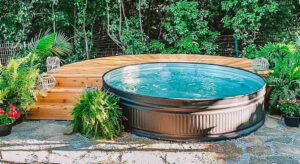
A typical model is around 10 ft in diameter, about 2 ft tall, and costs a few hundred dollars. While you could add a cheap filtration system, many people just empty the pool out after it starts getting dirty, then clean the sides and fill it up again.
Dumpster Pools
Yes, you can make a sturdy and intriguing swimming pool out of a dumpster. A dumpster pool is similar to a container pool, but it’s a bit smaller and usually needs less, if any, structural modifications. This is because dumpers are made with an open-top from the factory, and also have the strength to endure being filled with trash and rainwater.
The most famous dumpster pool online, shown above, was created by experimental architect Stefan Beese in New Orleans, Louisana. You can learn more about it from the Facebook Page, although the pool is no longer at his home.
Cheap Aboveground Pool
The last option we’ll cover are the cheap plastic aboveground pools you’ve probably seen before. These are a cheap way to get a pool but they aren’t very durable or strong.
There are different sizes, shapes, and options available, depending on your budget and requirements. Intex is probably the most well-known brand in this segment and has models like the one above all the way up to others costing over $1000.
Conclusion
If you’re interested in a swimming pool, but looking for another option besides a regular in-ground pool, shipping container pools can be a compelling choice. We’ve gone over pretty much everything about them including how and where to get one. And for those who decide a container pool just won’t meet their needs, we even covered some other alternatives a swell.
Let us know what you think about container pools in the comments below. Have you experienced one in person? Are they attractive to you? We’d love to hear your thoughts.

